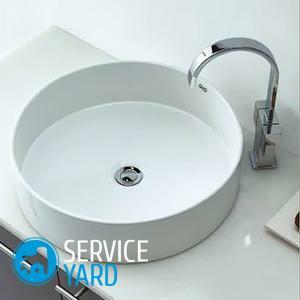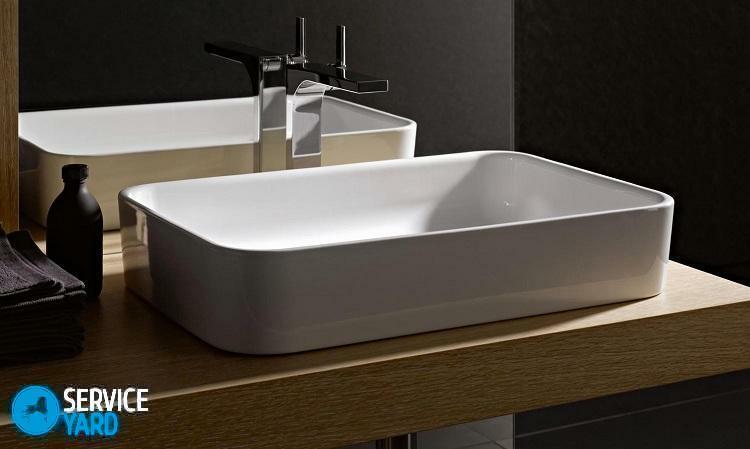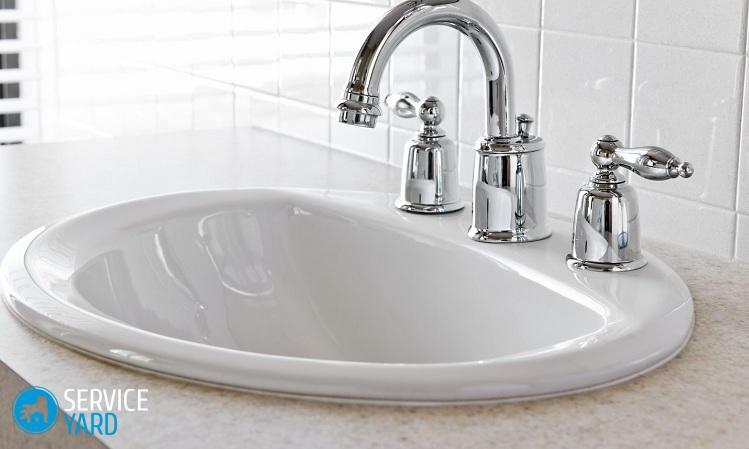
- What are the washbasins?
- How to mount
- What do you need?
- Preparing tools
- Preparing tools
- Determining the height
- Installing the suspension shell
- Installing the tulp
- Embedded or semi-recessed sink
- Overhead sink
- Final stage
During the repair work in the bathroom, the need to replace the plumbing equipment occurs quite often. There are situations when it is better to entrust the installation of a bathtub, toilet bowl or washbasin to professionals. But in most cases the owner, who knows how to handle tools, can cope with this task himself. Installing the sink in the bathroom - what are the features? Read about this in our article.
to the contents ↑What are the wash basins?
Construction shops offer customers a variety of different models of washbasins. They differ for a number of characteristics:
- material;
- dimensions;
- form;
- design;
- installation method.
Materials
Before installing the sink in the bathroom, you need to decide what exactly you want to put. Washbasins can be:
- metal:
- faience;
- porcelain;
- stone;
- glass;
- plastic;
- ceramic.
Important! Knowing the features of the material is important so as not to damage the shell during installation. If the steel sink is difficult to crush or break, as well as granite, then porcelain, faience, ceramics, and even more so plastic require careful handling.

Dimensions, shape, design
The choice of washbasin depends on the area of the room, the style that you have chosen, as well as your financial capabilities. Shells are:
- rectangular:
- oval;
- are round;
- in the form of a trapezoid with bevelled corners.
Important! On sale, you can find other options, and the most unexpected form. But still, the most popular are the oval, round and trapezoid. Rectangular and square are often put in kitchens.
to content ↑Mounting method
Mounting the washbasin in the bathroom very little depends on color, shape and size. The most important thing is the way of fastening. Washbasins can be:
- pendant;
- recessed;
- semi-recessed;
- waybills;
- on the foot.
Suspended
Suspended shell is fixed to the wall in two ways:
- on the bracket;
- on the studs.
Important! The option depends on the size and weight. A small light washbasin can be attached to the studs, for larger and heavier it is better to use brackets.
On the pedestals and worktops
Built-in and semi-recessed cut into the table or the cabinet. The difference between them lies in the fact that the first exactly fits into the surface of the support, and the individual parts of the second - protrude beyond the edges.
For a conch shell also need a support, only the car wash does not crash, but is put on top. As for the now popular "tulips", they usually have two legs - a leg and a wall.
Important! Sometimes there are models that rely only on the foot. In fact, such models can also to some extent be considered semi-built-they have very narrow supports.
to the contents ↑What are you going to do?
The installation of a washbasin is, albeit not always difficult, but responsible and requiring accuracy, as well as careful compliance with the technology. Otherwise, there may be trouble, and a constant puddle on the floor is the least that can happen.
The whole process can be divided into several stages:
- Dismantling of old equipment.
- Wall layout.
- Actually installation.
Preparing tools
Installing the washbasin in the bathroom will go much faster and easier if you prepare everything in advance. You will need some tools and fasteners:
- perforator or impact drill;
- drill bit for concrete;
- screwdriver set( or screwdriver);
- wrenches;
- gas wrench;
- screw anchors;
- sealant( usually used silicone);
- windings;
- building level;
- marker;
- long ruler or tape measure.
Dismantling the
equipment The first thing, of course, is to turn off the water. Fine, if it can be done in an apartment - in the vast majority of cases it is possible.
Important! In some very old houses it is necessary to disconnect the entire riser, and then it is better to call the plumber.
The equipment is removed in the following order:
- The mortise mixer should be removed by unscrewing the fastening nut.
- Disconnect the mixer from the water supply.
- Remove the sink.
- Remove the siphon by unscrewing the nut from the back of the sink with which the siphon is attached to the sink.
- If you want to replace the siphon, the old one must be disconnected from the pipe and the openings for the duration of the work should be plugged so that the smell of sewerage does not penetrate the apartment.
- Remove brackets or cabinet.
Important! Pipe piping is best placed in a basin or in a bucket - there could be water left.
to the contents ↑Determine the height of the
How to install a wash basin depends entirely on how many and which supports should be mounted. You should start with the definition of height. The standard distance from the floor is 85 cm. However, there are exceptions, if the growth of adult occupants of the apartment is very different from the average. Plus or minus 5 cm in either direction is completely acceptable.
to the contents ↑Installing the hanging sink
To install the hanging sink, you need to determine the place where it will be located. It is not difficult to do this, since installation is the final process when the sewer pipes are already installed. Drain the sink must be strictly above the outlet of the sewer.
Place the point under the connection point on the floor:
- From this point at a right angle to the floor, draw a vertical line on the wall.
- Mark on this line the height of the shell, put one more mark.
- With the help of the building level, through this mark, draw a horizontal line, strictly parallel to the floor - at this height will be the upper edge of the washbasin.
- Attach the sink to the wall so that the edge coincides with the line.
- Mark the holes for the fasteners.
- Drill holes.
- Fix the dowels.
- Insert the studs.
- Set the sink.
- Secure the fasteners.
- Fit the mixer.
- Connect the sink to the sewer.
Important! If the sink is heavy, put it better on the brackets, which are attached to one side of the equipment, and the other - to the wall. This fastening is more reliable, but the order of work will be almost the same as with the studs.

Mounting the mixer
If you do not change the mixer, but just removed it, so as not to interfere, there is no problem - it is mounted on the old place in the reverse order to the one in which you shot it.
Important! When dismantling, it is best to sketch or photograph each stage.
If you did not do this or replace the washbasin with a washbasin mixer, proceed as follows:
- Insert the fixing studs into the mixer.
- Insert the hoses for cold and hot water.
- Pass the hoses into the hole in the sink.
- Fix them from the back - for this, find the clamping washer with the sealing lid.
- Screw the hoses to the delivery pipes.
- Check the tightness of the connection.
Connecting to the sewer system
Securing the sink on the wall is not all. It must be connected to the water supply and sewerage. To connect the equipment to the sewer pipes, you need a bolt - usually it is included:
- Attach the grate to the top of the drain hole.
- The bottom of the hole is aligned with the drain pipe.
- Secure the entire structure with a bolt.
- Connect the hose from the siphon or corrugation to the sewage system.
- Do not forget to check the tightness of the connections.
We put the tulip
How to install the sink in the bathroom, if the equipment is placed on a vertical support? Such shells are called tulips. They are of two types - with or without wall mounting.
Important! In the first case, the installation is very similar to the installation of attachments. However, there are differences. You do not have to determine the height yourself; it has already been set - the leg can not be lengthened or trimmed, so it was necessary to think in advance about the distance between the sink and the floor.
In Action:
- Determine the location for support.
- Install and secure the foot as indicated in the instructions.
- Set the sink in the same way as the hanging.
And if you are considering how to put a sink in the bathroom without attaching it to the wall, it's even easier - you do not have to chop a wall. But there is one feature. All pipes are inside the support, so you need to connect the elements very reliably and accurately.
to the contents ↑Built-in or semi-recessed sink
Such designs are often placed in kitchens than in bathrooms. In fact, this is also a shell on the leg, only the support is wide and covers not only the siphon and sewer pipes, but also conceals part of the space.
Important! As with the tulip, you need to think about the height before starting the installation.
There are different types of pedestals and table tops, but in any case, the order of work will be the same as in the case of a tulip without fastening to the wall:
- Remove the mixer.
- Disconnect the siphon from the sink and drains or only from the sink.
- Install the cabinet - as a rule, it opens the front door, so you have access to the pipes.
- If necessary, attach the cabinet to the wall( this is done using dowels).
- Insert the sink into the opening of the countertop or curbstone.
- Connect the siphon.
- Connect the mixer.
Overhead sink
From other models it differs in that the pipes in the bathroom are hidden not in the curbstone but in the wall and covered with a decorative panel. It is beautiful, fashionable, but almost always requires serious preparation - the transfer of sewage and water. Therefore, installation is best entrusted to a professional plumber. In any case, it makes sense to consult with him - it is quite possible that you will have to make a special channel in the wall and conduct welding work.
to content ↑Final stage
After the sink is installed and all connections are checked, it is necessary to check the integrity of the entire system. This is done simply:
- Plug the drain hole with a stopper.
- Pour a full sink of water - this will give an opportunity to check how reliable the fasteners.
- Drain the water and see if it has started flowing through the joints.
Now you know all about how the installation of the sink in the bathroom, regardless of which model you preferred. We hope that you managed to cope well with the work, and neither households nor neighbors have any complaints during the operation of plumbing.



